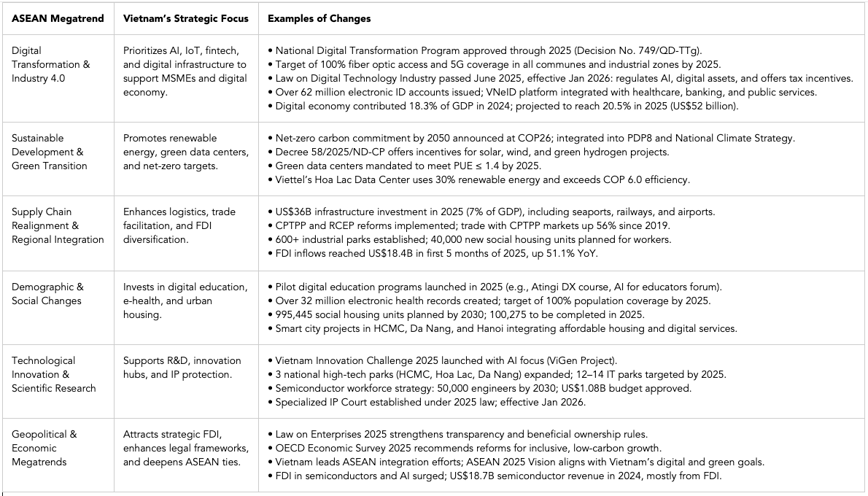Vietnam in 2025: A Strategic Hub for Global Investment Amidst Dynamic Reforms
7/1/20253 min read


Vietnam is strategically positioning itself as a leading investment destination in 2025, driven by comprehensive policy transformations across tax, business, trade, investment, legal, and geopolitical domains. These reforms are meticulously designed to align with emerging ASEAN megatrends and global economic shifts, enhancing the country's attractiveness while proactively addressing evolving challenges and opportunities.
Key Policy Transformations and Their Implications:
1. Tax and Business Policy Streamlining:
Vietnam is committed to fostering a more transparent, efficient, and investor-friendly tax environment. Key changes include:
Corporate Tax Reforms: Simplification of regulations and introduction of incentives, particularly for high-tech and sustainable industries.
Digitalization of Tax Administration: Enhanced ease of doing business and broadened tax base through digital initiatives, including mandatory non-cash payments for VAT input deduction and new tax withholding mechanisms for e-commerce platforms. The Amended Law on Corporate Income Tax, effective October 1, 2025, simplifies tax implications for foreign corporate shareholders in capital transfers.
2. Deepening Trade and Investment Integration:
Leveraging its network of trade agreements, Vietnam is enhancing its integration into regional and global value chains.
Diversification of Partners: Policies promote a broader range of trade partners and investment sources, in line with ASEAN's supply chain realignment strategies.
Sectoral Focus: Investment promotion is concentrated on Industry 4.0 technologies, renewable energy, and sustainable infrastructure. FDI inflows surged to nearly US$18.4 billion in the first five months of 2025, demonstrating strong investor confidence, particularly in high-tech industries, industrial real estate, and renewable energy.
Infrastructure Investment: Significant infrastructure development, including seaports, railways, and airports, is underway to boost logistics and trade facilitation.
3. Enhancing Legal and Regulatory Frameworks:
Legal reforms are aimed at bolstering investor confidence and supporting innovation-driven growth.
Intellectual Property Rights: Strengthened protections and streamlined registration procedures for trademarks and patents. A specialized IP Court is slated to be established under a 2025 law, effective January 2026.
Dispute Resolution: Improved mechanisms for dispute resolution, including recognition and enforcement of international arbitration awards, to ensure greater legal security for foreign investors.
Corporate Governance: The amended Law on Enterprises, effective July 1, 2025, introduces landmark shifts in corporate transparency (Ultimate Beneficial Ownership disclosure), capital accountability, and market-based valuation, reinforcing stricter compliance obligations.
Labor Law: The Vietnam Labor Law 2025, effective July 1, 2025, introduces significant changes to labor contracts, emphasizing employee rights, enhancing regulations around working hours, and streamlining work permit applications for foreign workers.
Electronic Transactions: Decree 23/2025/ND-CP on electronic signatures and trust services, effective April 10, 2025, along with the Draft Law on E-commerce, reinforces the legal validity and security of e-contracts.
4. Navigating the Geopolitical and Economic Landscape:
Vietnam is strategically positioning itself as a stable and reliable hub amidst global tensions and economic shifts.
Strategic Investment Attraction: Focused on attracting investments in semiconductors, defense technologies, and critical infrastructure, consistent with regional de-risking strategies.
Pro-Business Reforms: Continuous efforts to streamline administrative procedures, reduce compliance costs, and improve government efficiency to foster a more predictable business environment.
Implications for Foreign Businesses:
Opportunities
Vietnam is actively fostering growth in key sectors through robust policy support. The nation's strong push for digital transformation, including new laws on digital technology and investments in digital infrastructure, opens doors for tech-focused companies. Similarly, a clear commitment to sustainable development, exemplified by incentives for renewable energy and green data centers, creates avenues for environmentally conscious investments. Furthermore, substantial infrastructure development and ongoing trade reforms are enhancing logistics and diversifying supply chains, solidifying Vietnam's appeal as a manufacturing and export hub.
Challenges
Despite the attractive opportunities, foreign businesses must diligently adapt to Vietnam's evolving regulatory framework. Recent changes in tax administration, such as mandatory non-cash payments for VAT deductions and expanded tax withholding for e-commerce, require meticulous compliance. Additionally, the amended Law on Enterprises introduces stricter transparency rules, particularly regarding ultimate beneficial ownership, and new regulations on foreign ownership limits in certain sectors, necessitating thorough due diligence. While Vietnam aims to simplify administrative procedures, staying informed about these dynamic policy adjustments and potentially leveraging local expertise is crucial for smooth operations and risk mitigation.
Vietnam's Strategic Focus within ASEAN Megatrend
The ASEAN region is brimming with potential and emerging megatrends that present unparalleled opportunities for foreign investors. Vietnam, in particular, stands out as a prime example of how these trends can be leveraged for significant growth. By capitalizing on Vietnam's strategic reforms and dynamic market, businesses can gain a competitive edge.
At Terix Institute, we empower businesses to excel in diverse markets. Our seasoned experts provide tailored strategies to navigate complex policies, seize emerging opportunities, and mitigate risks.


TERIX INSTITUTE
+44 075 11930426
© 2023 Terix Institute